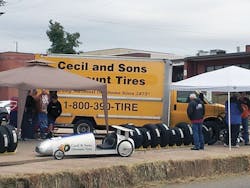Social media is not a one-size-fits-all proposition, and independent tire dealers admit they’re not expecting it to result in mega sales.
Troy Cox, co-owner of Cecil and Sons Discount Tires in Sands Springs, Okla., doesn’t expect a social media post to lure customers in the door to purchase tires. He thinks of the company’s Facebook profile more as a giant billboard where the business can show how it’s involved and invested in the community, and also share information about tires and other deals at its two stores outside of Tulsa.
Cecil and Sons created its Facebook page in 2009 and since 2012 has spent a couple hundred dollars a month to pay an outside contractor to create posts using information the business provides. The company has a Twitter account but doesn’t use it, and created a basic profile on Google+, where some customers have registered reviews.
“We don’t have full-time staff working it every day,” Cox says. “I think for us Facebook is a little more of an extension of our presence in the community. It’s another conversation.”
That means you’ll see just as many tire deals and safety reminders as posts about the community’s Chillin and Grillin barbecue weekend in October and the Halloween event, Boo on Broadway. The tire business sponsors and participates in these events, and Cox says Facebook is a good tool to spread the word about community activities. Plus, Cox says he’s more confident spending money on a booth at a community event or sponsoring a car during the Soapbox Derby knowing 1,000 people will see it. He’s less confident in the number of customers who might respond to a social media post. “When you’re a small business, throwing your very limited marketing dollars at an unknown is a concern,” Cox says.
Cox’s worries are common, and the Tire Industry Association recently sponsored a social media webinar for its members to help them as they make social media plans and goals for 2015. Michelle Bizon, social media manager for Moving Targets, told participants they have to find their comfort spot.
“It’s about finding what works for you and where you want to spend your time and effort,” Bizon says.
Kate Speelman, marketing coordinator for Rice Tire’s 10 locations in Maryland and Virginia, says she’s confident Facebook is the right place to reach customers. She has one goal – “to get more traffic to our website,” and says the company will experiment with its first paid advertisements on Facebook in 2015.
“Everything I’ve learned is that they’re extremely helpful to business,” Speelman says of the ads.
She’s hoping for better results than when the company experimented with an advertisement on Yelp. “We didn’t seem to get the return on investment.”
She doesn’t see Twitter or Instagram as a good fit for the family-owned tire business that started in 1956. Rice Tire created a page on LinkedIn, but Speelman admits it’s not a place customers go to find information on the business. She considers it a platform to give Rice Tire a professional look and add to its search engine optimization. She says LinkedIn has proven helpful in connecting with others in the tire industry, but it’s not a place where a lot of interaction takes place.
Before Jim Melvin Jr. became a tire guy he was a marketing guy. He, like Cox in Oklahoma, isn’t “100% that social media sells tires and brakes jobs.” But he sees value in the big picture of engaging with customers, and the Melvin’s Tire Pros homepage features a prominent “Be social with Melvin’s” button directing customers to its Facebook page.
Melvin, now the president of the company his father started 40 years ago in Rhode Island, says an outside company is paid to post about 90% of the content to the business’ Facebook page. Melvin himself is an administrator of the page and occasionally adds a photo of something unusual from one of the five stores. It adds up to daily posts, and Melvin says they’ve seen a steady stream of new followers.
“The vast majority of them are 20-year-olds,” Melvin says. “If we had an agenda with social media, they would certainly be it.”
While older or established customers might not be influenced by what the tire dealer posts online, Melvin says the opposite may be true for younger customers. “I’ve been in this business a long time. This business constantly changes and you’ve got to constantly change with it. When you get comfortable with something, that’s when it changes,” Melvin says. “I am not maybe the biggest proponent of social media, but I’ve done it long enough to know we can’t ignore it.” ■
About the Author
Joy Kopcha
Managing Editor
Joy Kopcha joined Modern Tire Dealer and Auto Service Professional as senior editor in 2014 after working as a newspaper reporter for a dozen years in Kansas, Indiana and Pennsylvania. She was named managing editor of MTD and ASP in 2022, and took on that same role with Motor Age in 2024.
She is an award-winning journalist, including in 2023 when she was named a Jesse H. Neal Awards Finalist.
Don't miss any of her articles. Sign up for MTD's newsletters.

